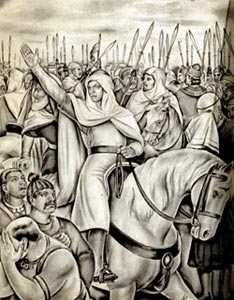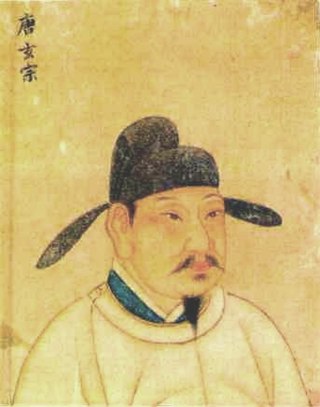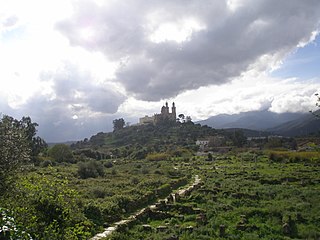The 430s decade ran from January 1, 430, to December 31, 439.
The 520s decade ran from January 1, 520, to December 31, 529.
The 480s decade ran from January 1, 480, to December 31, 489.
Year 431 (CDXXXI) was a common year starting on Thursday of the Julian calendar. At the time, it was known as the Year of the Consulship of Bassus and Antiochus. The denomination 431 for this year has been used since the early medieval period, when the Anno Domini calendar era became the prevalent method in Europe for naming years.

Year 635 (DCXXXV) was a common year starting on Sunday of the Julian calendar. The denomination 635 for this year has been used since the early medieval period, when the Anno Domini calendar era became the prevalent method in Europe for naming years.
Year 605 (DCV) was a common year starting on Friday of the Julian calendar. The denomination 605 for this year has been used since the early medieval period, when the Anno Domini calendar era became the prevalent method in Europe for naming years.

Year 422 (CDXXII) was a common year starting on Sunday of the Julian calendar. At the time, it was known as the Year of the Consulship of Honorius and Theodosius. The denomination 422 for this year has been used since the early medieval period, when the Anno Domini calendar era became the prevalent method in Europe for naming years.
Year 524 (DXXIV) was a leap year starting on Monday on the Julian calendar. In the Roman Empire, it was known as the Year of the Consulship of Iustinus and Opilio. The denomination 524 for this year has been used since the early medieval period, when the Anno Domini calendar era became the prevalent method in Europe for naming years.

Year 501 (DI) was a common year starting on Monday of the Julian calendar. At the time, it was known as the Year of the Consulship of Avienus and Pompeius. The denomination 501 for this year has been used since the early medieval period, when the Anno Domini calendar era became the prevalent method in Europe for naming years.

Year 565 (DLXV) was a common year starting on Thursday of the Julian calendar. The denomination 565 for this year has been used since the early medieval period, when the Anno Domini calendar era became the prevalent method in Europe for naming years.

Year 683 (DCLXXXIII) was a common year starting on Thursday of the Julian calendar. The denomination 683 for this year has been used since the early medieval period, when the Anno Domini calendar era became the prevalent method in Europe for naming years.

Year 684 (DCLXXXIV) was a leap year starting on Friday of the Julian calendar. The denomination 684 for this year has been used since the early medieval period, when the Anno Domini calendar era became the prevalent method in Europe for naming years.

Year 711 (DCCXI) was a common year starting on Thursday of the Julian calendar. The denomination 711 for this year has been used since the early medieval period, when the Anno Domini calendar era became the prevalent method in Europe for naming years.

Year 702 (DCCII) was a common year starting on Sunday of the Julian calendar, the 702nd year of the Common Era (CE) and Anno Domini (AD) designations, the 702nd year of the 1st millennium, the 2nd year of the 8th century, and the 3rd year of the 700s decade. The denomination 702 for this year has been used since the early medieval period, when the Anno Domini calendar era became the prevalent method in Europe for naming years.
Year 640 (DCXL) was a leap year starting on Saturday of the Julian calendar. The denomination 640 for this year has been used since the early medieval period, when the Anno Domini calendar era became the prevalent method in Europe for naming years.

Year 730 (DCCXXX) was a common year starting on Sunday of the Julian calendar. The denomination 730 for this year has been used since the early medieval period, when the Anno Domini calendar era became the prevalent method in Europe for naming years.

Year 900 (CM) was a leap year starting on Tuesday of the Julian calendar.

Year 435 (CDXXXV) was a common year starting on Tuesday of the Julian calendar. At the time, it was known in Rome as the Year of the Consulship of Theodosius and Valentinianus. The denomination 435 for this year has been used since the early medieval period, when the Anno Domini calendar era became the prevalent method in Europe for naming years.

Year 465 (CDLXV) was a common year starting on Friday of the Julian calendar. At the time, it was known as the Year of the Consulship of Hermenericus and Basiliscus. The denomination 465 for this year has been used since the early medieval period, when the Anno Domini calendar era became the prevalent method in Europe for naming years.

Year 583 (DLXXXIII) was a common year starting on Friday of the Julian calendar. The denomination 583 for this year has been used since the early medieval period, when the Anno Domini calendar era became the prevalent method in Europe for naming years.












